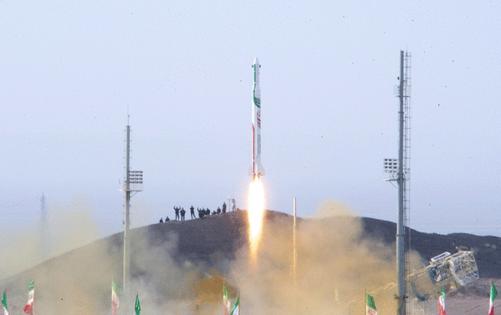Iran's space program is growing stronger despite US sanctions
Published in News & Features
Iran’s southeastern seaport of Chabahar is a popular tourist destination renowned for its cliff-lined beaches and rugged, treeless peaks known locally as “Martian mountains.” Soon the region will have more than just a poetic connection to outer space.
For years, construction has been underway to transform the sun-drenched coastal town into an economic hub, including a spaceport that’s set to open this year. The plan is to build the equivalent of Florida’s Cape Canaveral to anchor the Islamic Republic’s space ambitions.
It’s a program that President Donald Trump has tried to stop because the U.S. sees the technologies for space launches and ballistic missiles as virtually identical. During his first term, the U.S. imposed sanctions on Iran’s space agency, but that hasn’t prevented Iran from building one of the most advanced programs in the Middle East — with the Iranian Space Agency and the Islamic Revolutionary Guard Corps both sending rockets and satellites to orbit.
New projects include a network of 20 internet satellites named for Qassem Soleimani, the general killed in a Trump-ordered air strike in 2020.
Concerns over Iran’s development of both nuclear and missile technology have dominated the West’s relationship with the Islamic Republic for more than 20 years. Since Trump’s reelection, Tehran’s stockpile of uranium enriched near the level needed for nuclear arms has surged more than 50%, the International Atomic Energy Agency has said, once again raising concerns about its military potential.
Trump has urged Supreme Leader Ayatollah Ali Khamenei to agree to a new nuclear deal or face possible military action. Negotiators from Washington and Tehran conducted talks in Oman on April 12 and are preparing for a second meeting.
Iran has had to reassess its capabilities with its partners in Gaza and Lebanon weakened by fighting with Israel after the 2023 attacks by Hamas. Its Syrian ally Bashar al-Assad has also been overthrown by rebels. Western officials and experts increasingly see the Islamic Republic’s sophisticated space program as a key component of its defense capabilities.
“Iran’s work on space-launch vehicles — including its two-stage, liquid-fueled Simorgh satellite carrier rocket — likely shortens the timeline to produce an ICBM due to the similarities in technology,” General Anthony Cotton, commander of U.S. Strategic Command, said in prepared testimony to the Senate Armed Services Committee on March 26. Iran’s foreign ministry and the White House National Security Council didn’t respond to requests for comment on this article.
The Iranian space progress comes at a time when many nations and private companies are investing heavily to boost space military capabilities like spy satellites and satellite jammers.
Official figures for the total cost of Iran’s space program so far aren’t available. With the economy squeezed by U.S. sanctions, the government has continued to support its space program, albeit on tight budgets: Last November, a senior Iranian official said the space agency would receive around $11 million of financing to boost the sector.
It’s also gained from Iran’s stronger relationship with Russia in recent years. In January, Iranian President Masoud Pezeshkian signed a strategic partnership agreement with Russian President Vladimir Putin. Last year, a Russian rocket launched the first two privately-developed Iranian satellites to orbit. Russia is using Iranian-made drones in its war in Ukraine and is offering knowledge developed over decades of space exploration, said Juliana Suess, researcher at the German Institute for International and Security Affairs.
“What Russia definitely has is the expertise,” she said. “That’s something that Iran is after.”
Iran’s ability to launch more satellites could enable it to use spacecraft to better guide offensive weapons. Iranians “can become much more precise in their targeting and have quicker reaction times to launch their own ballistic missile forces to hit targets much more precisely,” said John Sheldon, Abu Dhabi-based founding partner at AstroAnalytica, a space consulting firm.
The West is increasingly concerned about the strategic and military implications of Iran’s advances. UK Prime Minister Keir Starmer’s government sanctioned Brigadier General Ali Jafarabadi, head of the Space Division of the Islamic Revolutionary Guard Corps’ Aerospace Force, last September and the Iranian Space Agency in October.
The EU also sanctioned Jafarabadi in October, saying his division was “involved in the development and future launch of satellite carriers, which are essential for the development of long-range ballistic missile systems.”
The IRGC, the powerful branch of Iran’s armed forces, was designated a terrorist organization by Trump during his first term.
Iranian leaders acknowledge space’s role in developing weapons, with Pezeshkian referring to Iran’s space program as a driving force behind its missile development.
“Our enemies constantly try to prevent us from standing on our own feet, but this has driven us to achieve scientific and technological advancements,” he said in February.
Although Iran has always denied it wants nuclear weapons and insists its uranium enrichment is for civilian purposes only, progress in space may offer Tehran an opportunity to assert resilience and strength.
“Iran has a need now, especially after the losses of its proxy power to Israel, to reestablish some kind of pathway to do power projection,” said Matthew Schmidt, associate professor of national security and political science at the University of New Haven. “They see space technology and aeronautical technology as a place to do it.”
Much depends on the success of Chabahar, a project that’s been plagued by delays and was meant to be ready by 2024. The opening is now set for this year, the Tehran Times newspaper reported in January, citing space agency chief, Hassan Salarieh.
When it’s finally finished, Chabahar will be a 14,000-hectare (54-square-mile) complex that will serve as Iran’s primary hub for space missions, he said.
Chabahar is critical to the Iranian government’s strategy, since the facility should increase the ability to launch more powerful spacecraft. Chabahar is also closer to the equator than Iran’s other launch sites, allowing rockets to take better advantage of the Earth’s spin compared to more northerly sites.
Working on large rockets for space “positions them better to be able to develop intercontinental ballistic missiles,” said John Caves, senior research associate at the Wisconsin Project on Nuclear Arms Control in Washington. Both a space rocket and an intercontinental ballistic missile can travel outside the Earth’s atmosphere.
“Some of the technology that you need to be able to have a missile go that far is similar to things that you would work on for a space launch vehicle,” he said. “There are some things that basically they can learn from working on the space launch vehicle that then they could apply to an ICBM.”
Iran’s neighbors are promoting pan-Arab partnership, with 14 countries taking part in the Arab Space Cooperation Group, said Mohamed Ibrahim Al Aseeri, CEO of Bahrain’s space agency.
Although he said Tehran’s “very advanced capabilities” didn’t pose a threat, Al Aseeri said in an interview that Bahrain needed to respond to the way Iran and other nations use space for military and security purposes. “It is a competition and the best way to deal with it is to be ready and to develop your own technology,” he said.
Meanwhile, Israeli officials have made public statements accusing Iran of using the space program as cover for military missile technologies.
Officials in Tehran argue that having a space program is about securing the same access to advanced technology that’s available to the West, rather than building a long-range missile threat to the U.S.
Sina Azodi, adjunct professor of international affairs at George Washington University, said it’s highly unlikely that Iran will use its space program to develop intercontinental ballistic missiles, knowing that they would be easily thwarted by the U.S.
“The accusation against Iran is that its space program is used to cover the pursuit of intercontinental ballistic missiles, but without nuclear warheads, it doesn’t make sense,” said Azodi. “What are you going to do with that ICBM? Set up a conventional warhead to attack the U.S.? Iran won’t do that.”
Much like its nuclear program, Iran sees space technology as something that can give it stature in the region and the wider world, beyond developing its military capabilities.
“Prestige is a major driver of these programs for Iran,” Dina Esfandiary, Middle East Geoeconomics analyst at Bloomberg Economics said.
Still, Iran has encountered many challenges, including delays in the opening of the Chabahar spaceport. Two satellite launches scheduled for the Iranian calendar year ending in March didn’t happen, with the space agency moving them to the new year.
Salarieh is already talking about even more ambitious projects such as advanced capsules capable of sending humans to space.
Iran's ability to achieve such goals could depend on the outcome of the negotiations with the U.S. The fact that the two sides are even talking is significant, said H.A. Hellyer, senior fellow at the Center for American Progress in Washington. “These were introductory talks, so not a great deal of substance should have been expected, but what did happen was still very symbolic," he said.
©2025 Bloomberg News. Visit at bloomberg.com. Distributed by Tribune Content Agency, LLC.







Comments